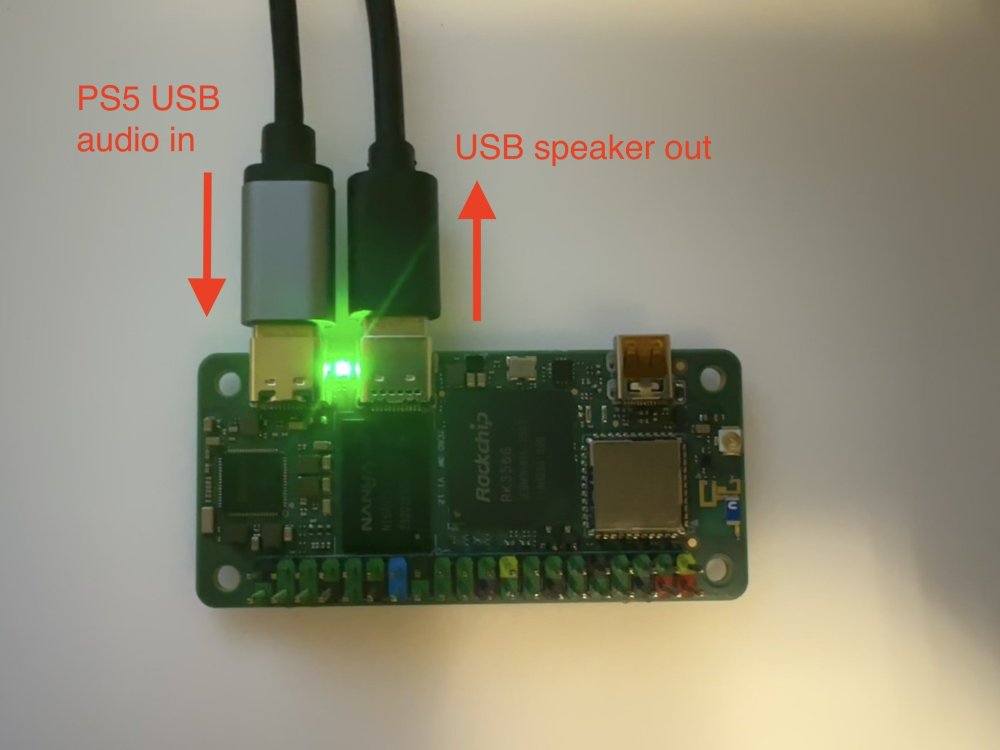All Activity
- Past hour
-

[SOLVED] 100% /var/log usage & rsyslogd high CPU load
ioncube replied to ioncube's topic in Radxa Zero 3W/3E
Solution found at -
My OS OS: Armbian (24.8.4) aarch64 Host: Radxa ZERO 3 Kernel: 6.1.75-vendor-rk35xx Uptime: 5 mins Packages: 1358 (dpkg) Shell: bash 5.2.21 Terminal: /dev/pts/0 CPU: (4) @ 2.000GHz Memory: 1168MiB / 7686Mi Reference Posts x2 I have this patch already in my /etc/systemd/journald.conf I edited /etc/default/armbian-zram-config -> ZRAM_PERCENTAGE=10 but allotment size didn't increase after a reboot (~47M before as well). By default this variable was commented out Filesystem Size Used Avail Use% Mounted on tmpfs 769M 24M 745M 4% /run /dev/mmcblk1p2 116G 32G 84G 28% / tmpfs 3.8G 100K 3.8G 1% /dev/shm tmpfs 5.0M 0 5.0M 0% /run/lock tmpfs 3.8G 4.0K 3.8G 1% /tmp /dev/md127 439G 65G 352G 16% /media/radxaRaid480gb /dev/mmcblk1p1 256M 157M 100M 62% /boot /dev/sdd1 117G 37G 75G 34% /media/radxa128gb /dev/zram1 47M 46M 0 100% /var/log
- Today
-

FriendlyElec CM3588Plus NAS - nvme's overheating (75C)
serverlesslove replied to serverlesslove's topic in Rockchip
I've also checked for good couple minutes with iotop while system was idle, only the rootfs was accessed which is on the internal eMMC. Next I will investigate more thoroughly using iotop and atop. -

Cubieboard 1 - No display output when booting Debian 12 image
Anb_o7 replied to Shakai2's topic in Allwinner sunxi
Hello, Using Armbian 23.11.1, I managed to upgrade to 25.5.2 with the hdmi output still working by pinning the version of linux-image-current-sunxi. So right now I have armbian 25.5.2 running with the kernel from 23.11.1 (6.1.63) and everything seems fine so far. I'll see if I can bisect the linux-image versions to find which one introduced the bug. Also note that apart from the hdmi output not working everything seems ok as I can ssh the cubieboard and use it as a headless machine without any issue. -

FriendlyElec CM3588Plus NAS - nvme's overheating (75C)
serverlesslove replied to serverlesslove's topic in Rockchip
Core Problem: Drives Stuck in PS0 at Idle drives remain in Power State (PS): 0 (4.5W consumption) and get burning hot in idle. While copying 500gb of video files over wifi, under low load, temps settled at 35-37C. --- All three of your NVMe drives (nvme0, nvme1, nvme2) are detected by the kernel. They are identified as Viper VP4300L 4TB drives. They are correctly initialized and made operational within your md0 RAID array. --- The output parm: default_ps_max_latency_us:max power saving latency for new devices; use PM QOS to change per device (ulong) confirms that the nvme_core module recognizes this parameter. However, this modinfo command only tells us about the parameter itself (its description and type), not the value that is currently active in your running kernel. We already confirmed that active value is 100000 from your previous cat /sys/module/nvme_core/parameters/default_ps_max_latency_us command. So, the situation remains: Your NVMe drives are staying in Power State 0 (consuming 4.5W each) and getting burning hot, even though the kernel is telling them "No Workload" and the default_ps_max_latency_us parameter is set generously high (100000 µs), which should allow them to enter deep sleep states. This strongly suggests that something is actively preventing them from entering sleep states, despite the ideal configuration. --- In the span of a few seconds: pi@omv:~$ sudo nvme get-feature /dev/nvme0n1 -f 0x02 -H get-feature:0x02 (Power Management), Current value:0x00000004 Workload Hint (WH): 0 - No Workload Power State (PS): 4 pi@omv:~$ sudo nvme get-feature /dev/nvme1n1 -f 0x02 -H get-feature:0x02 (Power Management), Current value:0x00000003 Workload Hint (WH): 0 - No Workload Power State (PS): 3 pi@omv:~$ sudo nvme get-feature /dev/nvme2n1 -f 0x02 -H get-feature:0x02 (Power Management), Current value:0x00000004 Workload Hint (WH): 0 - No Workload Power State (PS): 4 pi@omv:~$ sudo nvme get-feature /dev/nvme0n1 -f 0x02 -H get-feature:0x02 (Power Management), Current value:0x00000004 Workload Hint (WH): 0 - No Workload Power State (PS): 4 pi@omv:~$ sudo nvme get-feature /dev/nvme1n1 -f 0x02 -H get-feature:0x02 (Power Management), Current value:00000000 Workload Hint (WH): 0 - No Workload Power State (PS): 0 pi@omv:~$ sudo nvme get-feature /dev/nvme0n1 -f 0x02 -H get-feature:0x02 (Power Management), Current value:00000000 Workload Hint (WH): 0 - No Workload Power State (PS): 0 pi@omv:~$ sudo nvme get-feature /dev/nvme2n1 -f 0x02 -H get-feature:0x02 (Power Management), Current value:0x00000004 Workload Hint (WH): 0 - No Workload Power State (PS): 4 --- sudo nvme id-ctrl /dev/nvme0n1 -H | less ps 0 : mp:4.5000W operational enlat:0 exlat:0 rrt:0 rrl:0 rwt:0 rwl:0 idle_power:- active_power:- active_power_workload:- ps 1 : mp:2.4000W operational enlat:0 exlat:0 rrt:1 rrl:1 rwt:1 rwl:1 idle_power:- active_power:- active_power_workload:- ps 2 : mp:0.6000W operational enlat:0 exlat:0 rrt:2 rrl:2 rwt:2 rwl:2 idle_power:- active_power:- active_power_workload:- ps 3 : mp:0.0250W non-operational enlat:5000 exlat:5000 rrt:3 rrl:3 rwt:3 rwl:3 idle_power:- active_power:- active_power_workload:- ps 4 : mp:0.0040W non-operational enlat:5000 exlat:25000 rrt:4 rrl:4 rwt:4 rwl:4 idle_power:- active_power:- active_power_workload:- --- -
Some prerequisites. Distro: Debian 12 bookworm, xfce; Board: Orange Pi 4 LTS; Screen: Samsung SyncMaster 923NW, 1440x900_60, VGA. Using hdmi to vga adapter with vga cable. Tried one piece hdmi to vga cable. Tried other all in one adapter that goes in to the screen and goes to hdmi cable. The problem. While running armbian distro screen resolution is set to be 1080p by default. Using xrandr I can not set it to suggested 900p. Every time I set any other resolution - screen turns black until I set it back to 1080p. It is not a hardware issue, because right now I am running headless Debian bullseye from orange pi and the resolution is set 900p by default, it works. I have tried adding new modes, tried other resolutions and most of them have led me to the black screen. Brothers, I am confused. Any help is welcome.
-

Armbian 25.5.1 Noble Gnome can not open remote dosktop
Igor replied to 唐志's topic in Software, Applications, Userspace
Gnome uses Wayland and there some features don't work ... switch to X, where you will loose some functions, but remote desktop will work. FYI: https://gist.github.com/probonopd/9feb7c20257af5dd915e3a9f2d1f2277 -

T95 Max + (Plus) S905x3, 4GB RAM / 32B ROM
Pita Bread replied to Pita Bread's topic in TV Boxes running Armbian
Hello. Regarding a tv box, I briefly tried to connect a Realtek 8188 USB wifi adapter and get it working, but I quickly quit trying because there wasn't any appropriate firmware in Armbian or there was some other technical problem, and I didn't know to solve the problem. I know for certain that wifi adapter works in Linux, for example on a PC and in EmuElec. I tried only XFCE4. But yes, I can recommend LXDE and LXQt as an alternative to XFCE4 because they are lighter. ☺ -

Tanix TX3 mini unable to boot from Memory card
Pita Bread replied to tasknodes's topic in Amlogic CPU Boxes
@tasknodes as SteeMan requested, you should provide details and steps of how you installed Armbian. also provide details of what caused a boot failure and details of what error messages or logs that you saw on your tv/monitor. -

Armbian Newsletter Coordination Meeting
Igor commented on Michael Robinson's event in Community Calendar
@Contributor/Maintainer In case you are avail.- 1 comment
-
- Frequently asked question
- Other/unspec
-
(and 2 more)
Tagged with:
-
I have installed Armbian community images several times on different tv boxes that have an Amlogic S905x3, and usually there was no sound ♫. I wanted to get sound out of the tv box. So, I purchased a generic USB sound card audio dongle from Aliexpress for about $2 to $3 USD. (see attached photo). The USB audio device is described in Linux as a Texas Instruments PCM2902 Audio Codec (USB PnP Sound Device device 0 USB Audio), and when you run the command lsusb you will see the id numbers 08bb:2902. However, the specific hardware chip in the device that you receive may be different. I updated the databases for repositories by running sudo apt update -y and installed necessary packages to support the USB audio device and to use a graphical desktop such as XFCE4, for example: sudo apt install -y smplayer alsa-base alsa-oss alsa-tools alsa-utils alsamixergui pulseaudio pavucontrol pavumeter You can use smplayer or vlc or another as long as it is modern media player or audio player. Now make a backup copy of these two text files /etc/modules and /etc/modprobe.d/alsa-base.conf and save the backup copies in your home directory. Without quotes, edit the text file /etc/modules and write “snd-usb-audio” at the end of the file. Also, edit the text file /etc/modprobe.d/alsa-base.conf and change a few things. Put a hash # symbol in front of every “options snd-usb-audio index=-2” that you see in the file /etc/modprobe.d/alsa-base.conf . I found two of them. Add these two lines of text to the bottom of /etc/modprobe.d/alsa-base.conf without quotes. "alias snd-card-0 snd-usb-audio" "options snd-usb-audio index=0" Make sure that your user is in the 'audio' group. Run the usermod command against a regular user (not root) that you want to use often. And reboot. sudo usermod -a G audio {username here} sudo reboot Login to the graphical desktop, open the volume control program by clicking on the panel Applications, Multimedia, PulseAudio Volume Control. Click the Configuration tab at the far right of the volume control program and change the profile to Analog Stereo. * Important – now connect a headset, earphone, or amplifier to the 3.5mm (⅛’’) 🎧 headphone receptacle on the USB audio dongle and play some sounds, music or youtube. You can use wav audio files in the directory /usr/share/sounds/alsa/ if you don't have an internet connection.
-
thanks @Igor , this is really fresh like an hour ago would check in the rolling releases for images , it is deemed more stable for dram detection , sizing at boot. there tend to be dram size detection and other issues which I'm not too sure if that might be a timing related issue.
-
https://github.com/armbian/build/pull/8334
-
Personally, I would suggest to not even run a Desktop Environment, certainly not on a true IoT device. What GUI software do you plan to run? Are you aware that X can forward a GUI over ssh for you? Let's say you wanted to run blender and display the output at home or in your office on your shiny 27-inch, curved 4K display. OK. First, install the software on the IoT device "sudo apt install blender". Secondly, make sure X Forwarding is enabled on the IoT device "sudo grep X11Forwarding /etc/ssh/sshd_config" and make sure it is set to yes. Then, you should be having no problem to get blender to run on your IoT device but the GUI window will show on your large display with "ssh -X $IP-of-your-IoT-device", run this of course from your beefy machine. This works just the same for any other software you want to run remotely.
-

How to get the clock value of rk3288-cru?
laibsch replied to 李松錡's topic in Advanced users - Development
Have you tried to ask this in our discord server? -
I'm sorry, but I don't see where the problem is. Please be more specific.
-

Sound works but only with certain versions
laibsch replied to Reluctant Linux User's topic in Radxa Rock 5 ITX
it would be good to have those logs for a non-working setup. -

Create custom partition tables
eselarm replied to Alexander iLminsky's topic in Framework and userspace feature requests
check those files /usr/lib/systemd/system/armbian-resize-filesystem.service /usr/lib/armbian/armbian-resize-filesystem -
one way is if you have tested that config and build to make a pull request on github https://github.com/armbian/build
-
Good day. I built an image for SDCARD on the rockchip3568 board using the project from here https://github.com/armbian/build This framework creates an image for SDCARD, consisting of two partitions: 1 - boot (Fat32 - 256 MiB) 2 - root file system (ext4) (all remaining capacity on SDCARD, I use a 16GiB card) I need a different, custom, file system partition. How can I make three partitions, for example of these sizes: 1. boot - 256MiB 2. root - 2GiB 3. work - the entire remaining capacity of the SDCARD while the size of the image file is not all 16GiB, but 256MiB (boot) + 2Gib (root) + 256MiB (work) = 2.5GiB and the last partition would take up all the remaining space on the card? I managed to modify two scripts: partitioning.sh and rootfs-to-image.sh and, as I understood, to make the last partition for the entire remaining capacity of the card, when forming the script for marking partitions for sfdisk (in the partitioning.sh file), you do not need to specify the size of the partition, which is what I did. However, the desired result did not work. Can someone help with this problem? Thanks in advance.
-
Hi, I would like to share my recent work: a cheap USB Audio Class 1.0 (UAC) input to UAC 2.0 output converter. For folks that may not understand why I have this crazy idea, here is the background: For some shitty reasons, PS5 does not support outputting audio through certain USB sound card, and that is because PS5 only supports very old USB sound card (UAC 1.0), and usually high end speakers or sound cards would use newer, better UAC 2.0 protocol. So, this shitty thing happens to me, when I thought my EDIFIER S880 speaker would be a plus for my gaming experience. EDIFIER S880 has a UAC 2.0 in input source, so my PS5 does not support that. So, what I can do is to use another 3.5 jack to connect the speaker to my PS5. Unfortunately, there is a staticky buzz sound throughout this channel. What's even worse is that EDIFIER S880 has 6 input source selection, but I can only switch to the next source, wait for 2 seconds, and repeat this process 5 times every time I want to switch the audio from my computer to the PS5. After lots of trials and flashing my custom kernel, I finally did it! The idea is to use a board that has 1 USB otg port to act as a UAC 1.0 sound card, and has another 1 USB host port to connect to the UAC 2.0 speakers, then run programs on that board to redirect sound from USB otg port to USB host port. It is even a plus that the board consumes less power, so we do not need an extra or special power supply for it; this becomes crucial, especially when sharing the same USB connection with the USB otg port (SBC boards are more power-hungry these days!). The standard USB 2.0 protocol only allows 5V 0.5A to the device connected. I actually built one with an Orange Pi One board, but it turns out that the CPU is not fast enough, and there are sound glitches sometimes. With some research, I found this board that perfectly fits my needs: Radxa zero 3W. Here is the advantage: - It is cheap, and the one I used is the nearly minimum SKU (1 GB ram with 8 GB onboard eMMC, they also have no onboard eMMC SKU). - The otg port could handle USB PD protocol, meaning no special hacks are needed, you could get at most 30W of power, if needed (and turns out the normal USB 2.0 port on my PS5 works perfectly, so I guess it consumes less than 5V 1A = 5W) - It is tiny. However, things don't work right out of the box. At the beginning, I flashed the official, latest Radxa OS, modprobe the g_audio. It is running as a UAC 2.0 device, so it is not the one I want. As a result, I grabbed their kernel source, changed the config to UAC 1.0 gadget, and flashed onto the board, but there seems to be some issues in their kernel fork for UAC 1.0 driver: there was no /dev/snd/controlC0, so the g_audio failed to run. As a result, I turned to use the Armbian build. This time, the /dev/snd/pcmC0D0c is missing, so g_audio failed to run again. I then compiled my own kernel, flashed it onto the board. The Armbian build is with kernel 6.1, and the kernel I built is kernel 6.12, then the board failed to boot to the kernel due to U-Boot thought there were some errors. Luckily, I found that building the whole Armbian image with kernel 6.12 can boot without issues, so I built a custom kernel 6.12 with UAC 1.0 enabled image, modeprobe the g_audio module, and it finally worked! After that, I crafted a simple golang SystemV daemon for bootstrapping and terminating the alsaloop program for redirecting the sound, and used a udev rule to notify that daemon of the attachment/detachment of the USB speaker out event. The converter is finally working! Here is the pre-built image for folks who want a quick test. It is based on the commit b27c86e620dcd9f55daadf52ccc85643dba2a381 from the armbian build repo with the following config modification: diff --git a/config/kernel/linux-rockchip64-current.config b/config/kernel/linux-rockchip64-current.config index d053d0997..6e360bba7 100644 --- a/config/kernel/linux-rockchip64-current.config +++ b/config/kernel/linux-rockchip64-current.config @@ -3507,3 +3507,8 @@ CONFIG_RATIONAL_KUNIT_TEST=m CONFIG_MEMCPY_KUNIT_TEST=m CONFIG_TEST_MEMCAT_P=m CONFIG_MEMTEST=y + +CONFIG_USB_CONFIGFS_F_UAC1=y +CONFIG_USB_CONFIGFS_F_UAC2=n +CONFIG_USB_F_UAC2=n +CONFIG_GADGET_UAC1=y Currently, the "current" build does not detect the Wi-Fi interface, but as it does not affect the audio converting feature, I may not put too much effort into this.
-
I realize that OZPI v3 is supported by the community, but I would like to ask if anyone has information whether u-boot for OZPI v3 will be in version 2025.04 and is the estimated date known? Will armbian-config be fixed for OZPI v3 etc. problem using overlay-prefix in device tree? https://github.com/armbian/configng/issues/592
- Yesterday
-

Driving the ili9488 LCD (4.0 inch cheap chinese clone)
robertoj replied to robertoj's topic in Allwinner sunxi
Please someone help I can't start X11... I installed: sudo apt install xserver-xorg-video-fbdev openbox x11-xserver-utils xinit xserver-xorg-input-evdev Created this /etc/X11/xorg.conf.d/99-fbdev.conf file And tried sudo startx, then the LCD got a black screen for a fraction of a second, and I got (in my ssh session) The error message is FBIOPUT_VSCREENINFO: Invalid argument I also see that xorg wants to use 24 bit color, but my LCD is 18 bit color. I will try to get X11 working again with the linux 6.13 build folders that worked for me in april








